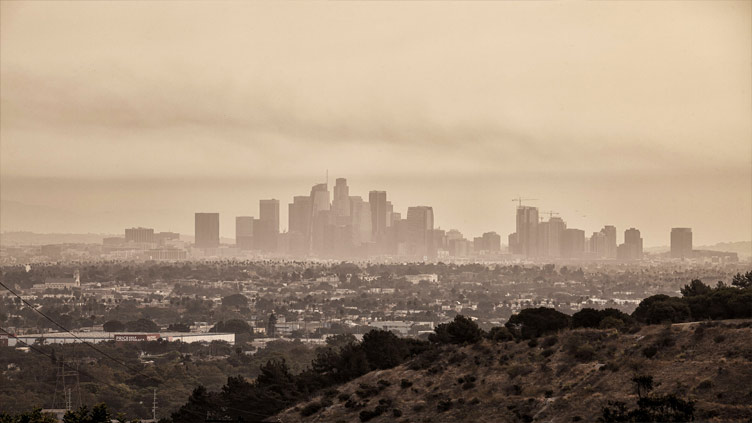California and other Western states see spikes in unhealthy air pollution as national levels improve

From 2019 to 2021, close to a half-million more people lived in counties with unhealthy spikes.
ISLAMABAD (Web Desk) - Fewer people in the U.S. are breathing unhealthy air now than a few years ago, but California and other Western states are seeing more dramatic short-term spikes in air pollution, according to a report the American Lung Association released Wednesday.
From 2019 to 2021, nearly 120 million people — around 36% of the U.S. — lived in a place with unhealthy levels of air pollution, the group’s “State of the Air” report found. That's down from 137 million people from a prior three-year period, 2018 to 2020. But pollution from events like wildfires has gotten worse, particularly in Western states.
“This year’s report has the highest number of people affected by short-term particles that we’ve ever seen in the history of the report,” said Katherine Pruitt, the report’s author and national senior director for policy at the American Lung Association.
From 2019 to 2021, close to a half-million more people lived in counties with unhealthy spikes in daily particle pollution compared to the 2018-20 period, the report found.
Particle pollution refers to a mixture of tiny pollutants from sources like factories, power plants, vehicles, wildfires and fireplaces. It's one of two types of air pollution the report measured, using data from the Environmental Protection Agency. The other, ozone smog, is a result of chemical reactions between pollutants from vehicles, factories or other industrial activities in the presence of sunlight.
The report scored air quality in cities and counties based on their average levels of ozone smog, as well as short-term and year-round particle pollution.
Wildfires were largely responsible for the short-term spikes, according to Richard Peltier, an associate professor of environmental health sciences at University of Massachusetts Amherst, who was not involved in the report.
“We’ve made great strides across the United States to improve our air quality, but we’re still getting pinched by these external effects like wildfires that are related to climate change,” he said.
On the bright side, the report found that the number of people living in counties with unhealthy levels of ozone pollution declined by more than 19 million in 2019-21 compared to 2018-20. And 1.5 million fewer people lived in counties with persistently unhealthy levels of year-round particle pollution.
"What we saw this year was ozone pollution in most parts of the country got better. Ozone has been slowly getting better, but this was a pretty dramatic improvement," Pruitt said.
Pollution hot spots in California
California cities dominated the report's rankings of the most polluted metropolitan areas in the U.S. Bakersfield, to the north of Los Angeles, ranked first for both short-term and year-round particle pollution (tied for the latter with Visalia, California). Pruitt said agricultural production in the area generates high levels of transportation pollution, particularly from trucks.
L.A. ranked first for ozone pollution, the same ranking it has held for all but one year in the report's 24-year history.
Pruitt and Peltier both said L.A. is a prime example of the challenges in reducing pollution in Western states. The area's dry summers are conducive to wildfires and many residents depend on cars for transportation.
L.A.'s geography also provides ideal conditions for ozone to form, since the surrounding mountains prevent air pollution from dispersing — what Peltier referred to as a “bathtub effect.”
“You get this kind of pooling of air pollution. It just gets stuck in the valley, and it sloshes around back and forth. As it does that, the concentrations build up, the ozone cooks,” he said.
Why is air quality improving nationally?
Peltier said broad declines in air pollution are a result of the Clean Air Act, which passed in 1970 and established national air quality standards.
“It takes years and years for cars to be built and new emission controls to be implemented, but eventually it does catch on,” he said.
The act's impact is especially clear on the East Coast, Pruitt said.
"The East has been able to enjoy the benefits of cleaner air without it being undercut by the heat and drought and wildfires that the West is experiencing," she said.
However, the report also highlighted disparities that aren't tied to a particular region: It found that people of color are nearly four times as likely as white people to live in a county with unhealthy levels of ozone smog and particle pollution.
Pruitt said highways, landfills, industrial facilities or power plants have commonly been built in economically disadvantaged communities of color.
Preventing pollution-related deaths
Both particle and ozone pollution have been linked to premature death.
Fine particulate matter — tiny particles in the air that are less than 4% of the diameter of a human hair — is responsible for nearly 48,000 premature deaths in the U.S. every year, according to the American Lung Association.
Peltier said exposure to particle pollution can lead to heart attacks and strokes, while ozone smog is more commonly associated with worsening asthma. But the U.S. has an opportunity to reduce these health hazards, Pruitt said, since the Inflation Reduction Act set aside $369 billion to tackle climate change and lower emissions.
Pruitt said that money should be distributed rapidly. Her report also called on the EPA to set stronger standards for particle and ozone pollution, and to finalize proposed restrictions on oil, gas and power plant emissions.
"That's really our call to action this year: The money that the IRA has set aside, let's get it spent wisely. And let's get the Biden administration ticking things off their to-do list," she said.


